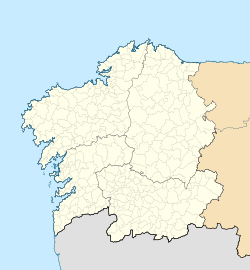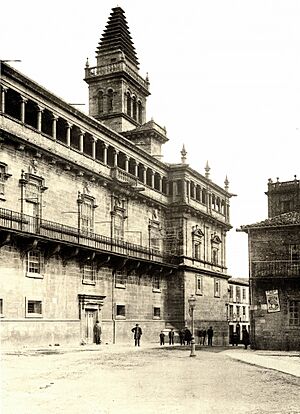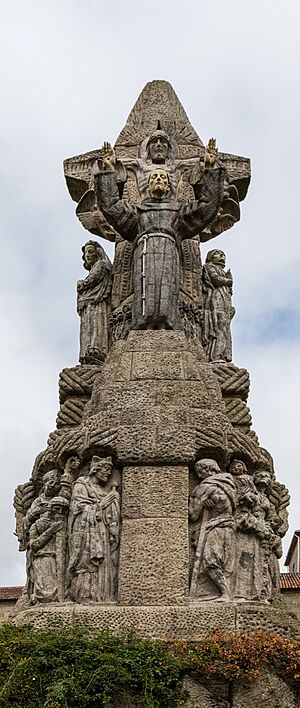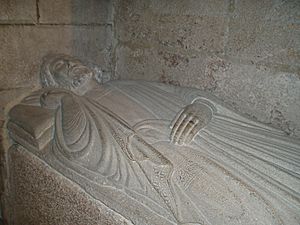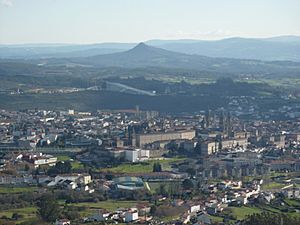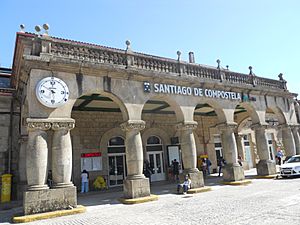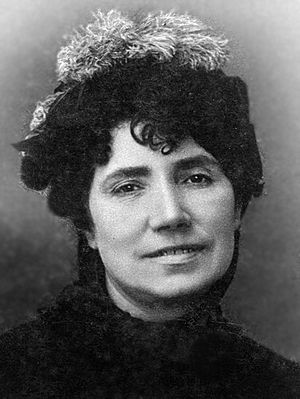Santiago de Compostela facts for kids
Quick facts for kids
Santiago de Compostela
|
|||
|---|---|---|---|
|
|
|||
|
|||
| Country | |||
| Autonomous Community | |||
| Province | A Coruña | ||
| Parishes |
30
Aríns
Bando A Barciela Busto O Carballal O Castiñeiriño Cesar Conxo O Eixo A Enfesta Fecha Figueiras Fontiñas Grixoa Laraño Marantes Marrozos Nemenzo A Peregrina Sabugueira San Caetano San Lázaro San Paio Santa Cristina de Fecha Santiago de Compostela Sar Verdía Vidán Villestro Vista Alegre |
||
| Government | |||
| • Type | Mayor–council | ||
| • Body | Council of Santiago | ||
| Area | |||
| • Municipality | 220 km2 (80 sq mi) | ||
| Elevation | 260 m (850 ft) | ||
| Population
(2020)
|
|||
| • Municipality | 97,849 | ||
| • Density | 445/km2 (1,152/sq mi) | ||
| • Metro | 183,855 | ||
| Demonym(s) | |||
| Time zone | CET (GMT +1) | ||
| • Summer (DST) | CEST (GMT +2) | ||
| Area code(s) | +34 | ||
Santiago de Compostela, also called Santiago or Compostela, is the capital city of Galicia, a region in northwestern Spain. It's located in the province of A Coruña. The city grew around the Cathedral of Santiago de Compostela, which is believed to hold the remains of Saint James the Great. It is the famous end point of the Way of St. James, a major pilgrimage route for Catholics since the 800s. In 1985, the city's Old Town was named a UNESCO World Heritage Site, meaning it's a very special place recognized globally.
Santiago de Compostela has a mild climate because it is close to the Atlantic Ocean. This means it gets a lot of rain in winter due to winds from the ocean.
Contents
- What's in a Name?
- Exploring Santiago's City Life
- How Santiago is Governed
- Santiago's Population
- Santiago's Long History
- Santiago's Economy
- The Way of St. James: A Famous Pilgrimage
- Main Places to See
- Getting Around Santiago
- Santiago's Sports Teams
- Famous People from Santiago
- Santiago's International Connections
- See Also
What's in a Name?
The name Santiago comes from an old Latin phrase, Sanctus Iacobus, which means "Saint James".
The word Compostela might come from Latin: Campus Stellae, meaning 'field of the star'. This idea comes from a legend about a guiding star. However, it's more likely that the name comes from other Latin words like Latin: compositum or Latin: Composita Tella, which mean 'burial ground'. It could also come from Latin: compositella, meaning "the well-composed one". Other places in Galicia have similar names.
Exploring Santiago's City Life
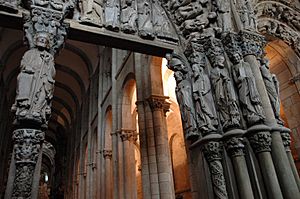
A medieval legend says that the body of Saint James was brought to Galicia for burial, but then it was lost. About 800 years later, a bright star guided a shepherd named Pelagius the Hermit to the burial spot in Santiago de Compostela. This place was originally called Mount Libredon.
The shepherd told the bishop of Iria, Theodemir, about his discovery. The bishop announced that these were the remains of Saint James. To honor Saint James, a grand cathedral was built on that very spot. This legend helped to strengthen Christian beliefs in northern Spain during the battles against the Moors. It also helped the city to grow and develop.
Next to the Praza do Obradoiro square is the beautiful 18th-century Pazo de Raxoi, which is now the city hall. Across the square is the Hostal dos Reis Católicos. This building was started in 1492 by the Catholic Monarchs, Isabella of Castille and Ferdinand II of Aragon. It was originally a place for pilgrims to stay and is now a fancy hotel. The famous front of the cathedral, called the Obradoiro façade, is shown on the Spanish 1, 2, and 5 cent euro coins.
Santiago is also home to the University of Santiago de Compostela, which was founded in the early 1500s. You can get a great view of the main campus from a spot in the large municipal park in the city center.
The old part of the city has many narrow, winding streets filled with historic buildings. The newer parts of the city are different, but some older sections of the new town have large apartment buildings.
Santiago de Compostela has a lively nightlife. Both the new town (called a zona nova in Galician) and the old town (called Galician: a zona vella) are busy until the early morning hours. The historic cathedral is in the center, surrounded by old granite streets. The largest park, Parque da Alameda, separates the old town from the newer parts of the city.
Santiago also gives its name to one of Spain's four military orders: Santiago, Calatrava, Alcántara, and Montesa.
The city is an important economic hub in Galicia. It is home to organizations like the Association for Equal and Fair Trade Pangaea.
Santiago's Climate
Santiago de Compostela has a mild oceanic climate. This means it has mild to warm, somewhat dry summers and mild, wet winters. The winds from the Atlantic and the nearby mountains cause Santiago to have some of the highest rainfall in Spain. It gets about 1,800 millimeters (71 inches) of rain each year.
Winters are mild, even though the city is inland and at an altitude of 370 meters (1,210 feet). Frosts are rare, happening only about 13 days a year, mostly in December, January, and February. Snow is also uncommon, falling only about 2-3 days per year. Temperatures above 35°C (95°F) are very rare.
| Climate data for Santiago de Compostela (1991–2020) (Provisional Normals) | |||||||||||||
|---|---|---|---|---|---|---|---|---|---|---|---|---|---|
| Month | Jan | Feb | Mar | Apr | May | Jun | Jul | Aug | Sep | Oct | Nov | Dec | Year |
| Record high °C (°F) | 20.3 (68.5) |
23.2 (73.8) |
27.6 (81.7) |
30.2 (86.4) |
34.0 (93.2) |
37.8 (100.0) |
39.4 (102.9) |
39.0 (102.2) |
39.0 (102.2) |
30.4 (86.7) |
24.2 (75.6) |
23.4 (74.1) |
39.4 (102.9) |
| Mean daily maximum °C (°F) | 12.3 (54.1) |
13.4 (56.1) |
16.0 (60.8) |
17.3 (63.1) |
19.8 (67.6) |
22.8 (73.0) |
24.8 (76.6) |
25.0 (77.0) |
23.2 (73.8) |
19.6 (67.3) |
14.8 (58.6) |
12.9 (55.2) |
18.5 (65.3) |
| Daily mean °C (°F) | 8.9 (48.0) |
9.5 (49.1) |
11.3 (52.3) |
12.5 (54.5) |
15.0 (59.0) |
17.8 (64.0) |
19.6 (67.3) |
19.9 (67.8) |
18.2 (64.8) |
15.3 (59.5) |
11.2 (52.2) |
9.4 (48.9) |
14.1 (57.3) |
| Mean daily minimum °C (°F) | 5.4 (41.7) |
5.6 (42.1) |
6.5 (43.7) |
7.7 (45.9) |
10.1 (50.2) |
12.6 (54.7) |
14.4 (57.9) |
14.6 (58.3) |
13.1 (55.6) |
10.9 (51.6) |
7.5 (45.5) |
5.9 (42.6) |
9.5 (49.2) |
| Record low °C (°F) | −7.0 (19.4) |
−9.0 (15.8) |
−5.6 (21.9) |
−3.0 (26.6) |
−2.0 (28.4) |
3.4 (38.1) |
3.4 (38.1) |
1.0 (33.8) |
3.0 (37.4) |
−1.6 (29.1) |
−3.2 (26.2) |
−6.5 (20.3) |
−9.0 (15.8) |
| Average rainfall mm (inches) | 195.8 (7.71) |
151.0 (5.94) |
139.9 (5.51) |
130.0 (5.12) |
109.2 (4.30) |
44.3 (1.74) |
30.6 (1.20) |
45.2 (1.78) |
88.6 (3.49) |
214.0 (8.43) |
193.6 (7.62) |
184.4 (7.26) |
1,526.6 (60.1) |
| Source: Agencia Estatal de Meteorología | |||||||||||||
| Climate data for Santiago de Compostela Airport (1981–2010) altitude 370 metres (1,210 ft) m.a.s.l. Extremes 1944−2021 | |||||||||||||
|---|---|---|---|---|---|---|---|---|---|---|---|---|---|
| Month | Jan | Feb | Mar | Apr | May | Jun | Jul | Aug | Sep | Oct | Nov | Dec | Year |
| Record high °C (°F) | 20.3 (68.5) |
23.2 (73.8) |
27.6 (81.7) |
30.2 (86.4) |
34.0 (93.2) |
37.8 (100.0) |
39.4 (102.9) |
39.0 (102.2) |
39.0 (102.2) |
30.4 (86.7) |
24.2 (75.6) |
23.4 (74.1) |
39.4 (102.9) |
| Mean daily maximum °C (°F) | 11.2 (52.2) |
12.5 (54.5) |
15.0 (59.0) |
16.1 (61.0) |
18.6 (65.5) |
22.2 (72.0) |
24.3 (75.7) |
24.7 (76.5) |
22.8 (73.0) |
18.1 (64.6) |
14.1 (57.4) |
11.9 (53.4) |
17.6 (63.7) |
| Daily mean °C (°F) | 7.7 (45.9) |
8.3 (46.9) |
10.2 (50.4) |
11.2 (52.2) |
13.6 (56.5) |
16.8 (62.2) |
18.6 (65.5) |
19.0 (66.2) |
17.4 (63.3) |
13.8 (56.8) |
10.4 (50.7) |
8.5 (47.3) |
13.0 (55.4) |
| Mean daily minimum °C (°F) | 4.1 (39.4) |
4.1 (39.4) |
5.4 (41.7) |
6.2 (43.2) |
8.5 (47.3) |
11.3 (52.3) |
13.0 (55.4) |
13.3 (55.9) |
11.9 (53.4) |
9.5 (49.1) |
6.7 (44.1) |
5.0 (41.0) |
8.3 (46.9) |
| Record low °C (°F) | −7.0 (19.4) |
−9.0 (15.8) |
−5.6 (21.9) |
−3.0 (26.6) |
−2.0 (28.4) |
3.4 (38.1) |
3.4 (38.1) |
1.0 (33.8) |
3.0 (37.4) |
−1.6 (29.1) |
−3.2 (26.2) |
−6.5 (20.3) |
−9.0 (15.8) |
| Average rainfall mm (inches) | 210 (8.3) |
167 (6.6) |
146 (5.7) |
146 (5.7) |
135 (5.3) |
72 (2.8) |
43 (1.7) |
57 (2.2) |
107 (4.2) |
226 (8.9) |
217 (8.5) |
261 (10.3) |
1,787 (70.4) |
| Average precipitation days (≥ 1 mm) | 15.2 | 12.6 | 12.8 | 14.4 | 12.7 | 7.6 | 5.7 | 5.5 | 8.4 | 14.0 | 14.9 | 15.9 | 139.5 |
| Average snowy days | 1.0 | 0.7 | 0.2 | 0.3 | 0 | 0 | 0 | 0 | 0 | 0 | 0.1 | 0.3 | 2.7 |
| Average relative humidity (%) | 84 | 79 | 75 | 76 | 76 | 74 | 74 | 74 | 75 | 82 | 86 | 85 | 78 |
| Mean monthly sunshine hours | 93 | 114 | 151 | 165 | 187 | 225 | 243 | 237 | 184 | 132 | 95 | 85 | 1,911 |
| Source: Agencia Estatal de Meteorología | |||||||||||||
| UNESCO World Heritage Site | |
|---|---|
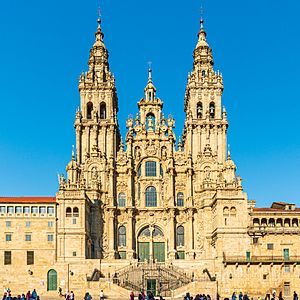
The Obradoiro façade of the grand Cathedral of Santiago de Compostela
|
|
| Criteria | Cultural: i, ii, vi |
| Inscription | 1985 (9th Session) |
| Area | 107.59 ha |
| Buffer zone | 216.88 ha |
How Santiago is Governed
The city is run by a mayor–council system. This means there's a mayor and a city council who make decisions. After the 2023 Spanish local elections, the current mayor of Santiago is Goretti Sanmartín from the BNG party.
Santiago's Population
In 2019, the city had 96,260 people living in it. The larger metropolitan area, which includes nearby towns, had about 178,695 people.
In 2010, about 4,111 people living in Santiago were from other countries. This was about 4.3% of the total population. The largest groups of foreigners were from Brazil (11%), Portugal (8%), and Colombia (7%).
When it comes to languages, in 2008, about 21% of the people always spoke Galician. About 15% always spoke Spanish. Many people spoke a mix, with 31% mostly speaking Galician and 32% mostly speaking Spanish. A 2010 study showed that 38.5% of primary and secondary students in the city had Galician as their first language.
Santiago's Long History
The area where Santiago de Compostela now stands was a Roman cemetery around the 300s. In the early 400s, the Suebi people settled there during the fall of the Roman Empire. Later, in the 500s, it became part of the bishopric of Iria Flavia. In 585, the Visigothic Kingdom took control of the area.
Around the 700s, the bishopric of Iria became part of the Kingdom of Asturias. Between 818 and 842, during the rule of King Alfonso II of Asturias, Bishop Theodemar of Iria claimed to have found the remains of Saint James the Greater. This discovery was important because it helped connect the Kingdom of Asturias with powerful leaders like Pope Leo III and Charlemagne. A new settlement and a pilgrimage center grew around this discovery. By the 900s, it was known as Compostella.
The devotion to Saint James in Compostela was one of many new religious practices in northern Spain during the 900s and 1000s. After the main political power moved from Oviedo to León in 910, Compostela became more important. Several kings of Galicia and León were crowned in the cathedral. By 1111, Compostela had become the capital of the Kingdom of Galicia. Later, kings like Fernando II and Alfonso IX were buried in the cathedral.
During the 900s and early 1000s, Viking raiders tried to attack the town. Bishop Sisenand II, who died fighting them in 968, ordered a walled fortress to protect the holy site. In 997, Ibn Abi Aamir (al-Mansur) attacked and partly destroyed Compostela. In response, Bishop Cresconio built walls and defensive towers around the entire town in the mid-1000s.
Some historians believe that by the mid-1000s, Santiago was already a major pilgrimage site for all of Europe. Others think that the devotion to Saint James was mainly a Galician matter before the 1100s. Over the next century, Santiago became a major Catholic shrine, second only to Rome and Jerusalem. In the 1100s, Bishop Diego Gelmírez helped Compostela become an archbishopric, attracting many people from different countries.
During this time, the people of the city often rebelled against the local bishop, who was the city's ruler. This fight for self-government continued for centuries. A key moment happened in the 1300s when Bishop Bérenger de Landore tricked and executed the city's leaders.
Santiago de Compostela was captured and looted by the French during the Napoleonic Wars. Because of this, the remains believed to be of the apostle were hidden in the cathedral's crypt for almost a century.
Excavations in the cathedral during the 1800s and 1900s found an old Roman burial site. This site shows that there was an ancient Christian holy place there, which later became a small cemetery.
Santiago's Economy
Santiago's economy relies a lot on public services, like being the home of the Galician government. It also depends on cultural tourism, industries, and its university. However, the economy is growing and becoming more diverse. New industries have started, such as wood processing (FINSA), car manufacturing (UROVESA), and telecommunications and electronics (Blusens and Televés).
Tourism is very important because of the Way of St. James. This is especially true in Holy Compostelan Years, which happen when the Feast of Saint James falls on a Sunday. After a big effort by the Galician government and a successful advertising campaign in 1993, the number of pilgrims finishing the route has been growing steadily. More than 272,000 pilgrims completed the journey in the Holy Year of 2010. Even outside of Holy Years, many pilgrims still visit the city. For example, in 2013, 215,880 people finished the pilgrimage. In 2016, this number grew to 277,854 people.
Editorial Compostela owns the daily newspaper El Correo Gallego, a local TV station, and a radio station. The Galician-language online news site Galicia Hoxe is also based in the city. Televisión de Galicia, which is Galicia's public TV company, has its main offices in Santiago.
The Way of St. James: A Famous Pilgrimage
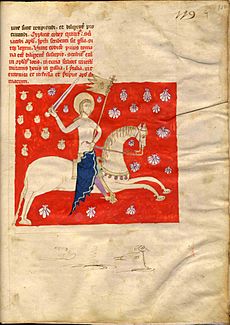
The legend says that Saint James traveled to the Iberian Peninsula (Spain and Portugal) and preached there. This is one of several old stories about where Jesus's apostles traveled and where they were buried. Although a Papal document from Pope Leo XIII in 1884 said the relics in Compostela were real, the Vatican doesn't officially confirm if they are truly the remains of Saint James the Greater. However, the Vatican still encourages people to make the pilgrimage to the site. Pope Benedict XVI even made a special visit to the site in 2010.
Legends of the Way
According to a tradition from the 1100s, recorded in the Codex Calixtinus, Saint James decided to go back to the Holy Land after preaching in Galicia. There, he was executed. But his followers took his body to Jaffa, where they found a wonderful stone ship. This ship miraculously carried them and the apostle's body back to Iria Flavia in Galicia.
There, the followers asked the local pagan queen, Loba (meaning 'She-wolf'), for permission to bury the body. She was annoyed and tried to trick them. She sent them to get a pair of oxen she supposedly had near the Pico Sacro, a sacred mountain where a dragon lived. She hoped the dragon would kill the Christians. But when the dragon attacked, it exploded at the sight of the cross. Then, the followers went to get the oxen. These were actually wild bulls that the queen used to punish her enemies. But again, at the sight of the Christian cross, the bulls became calm. They were then yoked and carried the apostle's body to the place where Compostela is now. This legend was also mentioned with small changes by the Czech traveler Jaroslav Lev of Rožmitál in the 1400s.
The relics were said to have been found again in the 800s by a hermit named Pelagius. He saw strange lights in a local forest and went to get help from the local bishop, Theodemar of Iria. The legend says that Theodemar was then guided to the spot by a star. This is why "Compostela" is sometimes thought to come from Campus Stellae, meaning "Field of Stars."
In the 1400s, the red flag that guided the Galician armies into battle was kept in the Cathedral of Santiago de Compostela. It showed Saint James riding a white horse, wearing a white cloak, and holding a sword. The legend of Saint James miraculously appearing as a white knight to help Christians fight Muslims was a popular story during the Middle Ages.
The Shrine's Beginning
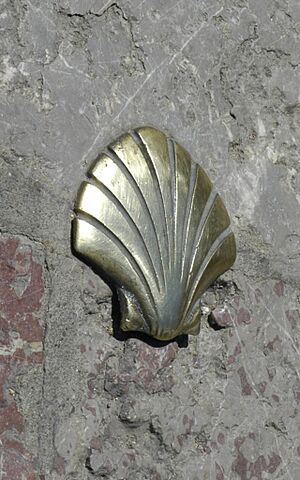
The 1,000-year-old pilgrimage to the shrine of Saint James in the Santiago de Compostela Cathedral is known as the Way of St. James (or Camino de Santiago in Spanish). Each year, over 200,000 pilgrims travel to the city from all over Europe and other parts of the world. This pilgrimage has been the topic of many books, TV shows, and movies.
Old Legends of the Area
Because the city's location was the lowest land on that part of the coast, it became very important. Old Celtic legends said it was the place where the souls of the dead gathered to follow the sun across the sea. Those who were not worthy of going to the Land of the Dead were said to haunt Galicia as the Santa Compaña or Estadea.
Main Places to See
- Cathedral of Santiago de Compostela
- University of Santiago de Compostela
- Pazo de Raxoi – This building serves as the city hall and the office of the President of the Xunta of Galicia.
- The 12th-century Colexiata de Santa María do Sar
- The 16th-century Baroque Abbey of San Martín Pinario
- The 17th-century Convent and Church of San Francisco
- Centro Galego de Arte Contemporánea (Galician Center for Contemporary Art), designed by Alvaro Siza Vieira
- City of Culture of Galicia, designed by Peter Eisenman
- Muralla de Santiago de Compostela (Santiago de Compostela Wall)
- Parque da Alameda (Alameda Park)
- Parque de Carlomagno (Carlomagno Park)
- Parque de San Domingos de Bonaval, redesigned by Eduardo Chillida and Alvaro Siza Vieira
Getting Around Santiago
Santiago de Compostela has its own airport, Santiago de Compostela Airport, and a Renfe train service.
Airport
Santiago de Compostela Airport is the second busiest airport in northern Spain, after Bilbao Airport. The airport is in Lavacolla, about 12 kilometers (7.5 miles) from the city center. In 2019, it handled over 2.9 million passengers.
Railway
Santiago de Compostela railway station is connected to Spain's High-Speed Railway Network. You can reach Madrid in just 3 hours by train.
You can also get to Porto in less than 5 hours by changing to the Celta train in Vigo.
On July 24, 2013, there was a serious train accident near the city. 79 people died and at least 130 were injured when a train went off the tracks on a curve as it approached Compostela station.
Santiago's Sports Teams
- SD Compostela (football) - They played 4 seasons in La Liga.
- Obradoiro CAB (basketball) - They played 11 seasons in Liga ACB.
- Santiago Futsal (futsal) - They played 15 seasons in LNFS.
- Santiago Black Ravens (American football) - They played 2 seasons in LNFA and 2 seasons in LPFA.
- Arteal Tenis de Mesa (table tennis) - They played 12 seasons in SDTM.
- Escudería Compostela (motorsport) - They organize the Rally Botafumeiro.
- Santiago Rugby Club (rugby union)
- Estrela Vermelha FG (Gaelic football)
Famous People from Santiago
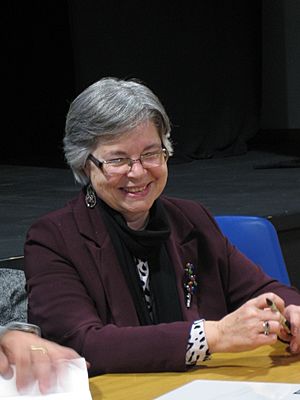
- Bernal de Bonaval (1200s), a troubadour (poet and musician) from Galicia.
- Juan Antonio García de Bouzas (c.1680–1755), a Baroque painter whose main works are in Santiago's churches.
- Eugenio Montero Ríos (1832–1914), a politician who was briefly Prime Minister of Spain in 1905.
- Rosalía de Castro (1837–1885), a famous romantic writer and poet.
- Modesto Brocos (1852–1936), a Brazilian painter, designer, and engraver.
- Carmen Babiano Méndez-Núñez (1852–1914), a painter and a pioneer for women in art.
- Manuel Maria Puga y Parga (1874–1918), known as "Picadillo," a culinary writer who made traditional Galician cooking popular.
- Xerardo Fernández Albor (1917–2018), a doctor and politician who was president of Galicia from 1981 to 1987.
- Isaac Díaz Pardo (1920–2012), an intellectual, painter, and businessman.
- Xohana Torres (1931–2017), a writer, poet, and playwright.
- Ana Romero Masiá (born 1952), a historian, archaeologist, and academic.
- Mariano Rajoy (born 1955), a politician who was Prime Minister of Spain from 2011 to 2018.
- Yolanda Castaño (born 1977), a painter, literary critic, and poet.
- Roi Méndez (born 1993), a singer and guitarist.
Sports Stars

- José Luis Veloso (1937–2019), a footballer with 278 professional appearances.
- Tomás Reñones (born 1960), known as Tomás, a footballer with almost 500 professional appearances.
- Moncho Fernández (born 1969), a basketball manager and coach.
- Emilio José Viqueira (born 1974), a footballer who made 454 professional appearances.
- Borja Golan (born 1983), a professional squash player who represents Spain.
- Verónica Boquete (born 1987), a famous female footballer.
- Borja Iglesias (born 1993), a footballer for Real Betis.
Santiago's International Connections
Santiago de Compostela has "twin city" relationships with many cities around the world. This means they share cultural ties and promote friendship.
 Assisi, Italy (2008)
Assisi, Italy (2008) Barcelona, Spain
Barcelona, Spain Braga, Portugal
Braga, Portugal Buenos Aires, Argentina (1980s)
Buenos Aires, Argentina (1980s) Cáceres, Spain
Cáceres, Spain Caracas, Venezuela
Caracas, Venezuela Coimbra, Portugal (1994)
Coimbra, Portugal (1994) Córdoba, Spain
Córdoba, Spain Mashhad, Iran
Mashhad, Iran Las Piedras, Uruguay (2010)
Las Piedras, Uruguay (2010) Le Puy-en-Velay, France
Le Puy-en-Velay, France Oviedo, Spain
Oviedo, Spain Pisa, Italy (2010)
Pisa, Italy (2010) Qom, Iran
Qom, Iran Qufu, People's Republic of China
Qufu, People's Republic of China Rennes, France (2010)
Rennes, France (2010) Santiago, Chile
Santiago, Chile Santiago de Cali, Colombia
Santiago de Cali, Colombia Santiago de Cuba, Cuba
Santiago de Cuba, Cuba Santiago de las Vegas, Cuba
Santiago de las Vegas, Cuba Santiago de los Caballeros, Dominican Republic (2004)
Santiago de los Caballeros, Dominican Republic (2004) Santiago de Querétaro, Mexico (2005)
Santiago de Querétaro, Mexico (2005) Santiago de Veraguas, Panama
Santiago de Veraguas, Panama Santiago do Cacém, Portugal (1980s)
Santiago do Cacém, Portugal (1980s) Santiago Tuxtla, Mexico
Santiago Tuxtla, Mexico São Paulo, Brazil
São Paulo, Brazil
See Also
 In Spanish: Santiago de Compostela para niños
In Spanish: Santiago de Compostela para niños









